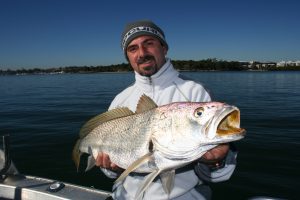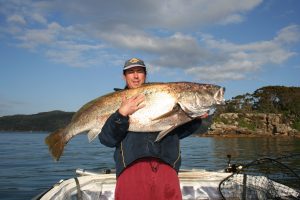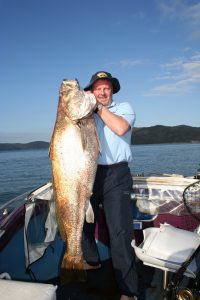DAYLIGHT JEWIES
Jewies don’t fight particularly well for their size, they don’t jump, they are not common and they are nothing special on the table.
So, what’s all the fuss about? Why do dedicated jewie fishos spend hundreds of hours for relatively few fish and probably just as many hours dreaming about them?
Unfortunately it’s a question that I can’t answer in words. To know the answer, you have to be peering over the side of the boat at the precise time a big jewie materializes from to the depths and glides to the surface. You have to be there as it lays on the deck with shades of gold, bronze and silver glisten through a purple \pink hue. You have to smell them.
This article relates specifically to chasing them during the day
Most of my experience chasing jews is in the Sydney area, particularly Sydney Harbor, Cowan and Berowra creeks. I’m pretty sure though that these techniques should work elsewhere.
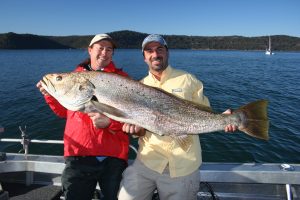
BAITS
I’ve given live baits more than a fair go. For three years I swam live yackas alongside my squid baits and in that time the yakka never got taken. Sometimes we would have jewies on all three squid baits at the same time and the remaining yakka would go untouched. Land the jewies, re bait with squid and drop them back down right next to the yakka and the squid would get hit almost instantly.
To drive the point home, let me fully clarify what went on below the surface. A large school of jewies moved in under my boat. There were four baits to choose from, three squid and one yakka. The jewies took all three squid and left the yakka alone. At this point you could be excused for thinking that there were only three jewies down there. But when we dropped another three squid baits down and caught another three jewies, it became obvious that there was a large school down there. Still the yakka remained untouched. The jewies ranged in size from three to six kg so they were more than capable of swallowing the yakka. This scenario was repeated on many occasions. I won’t go as far as saying that jewies don’t eat or like yakkas but I know for sure that if they have the choice they will always choose squid before yakka.
Of course if you only ever use yakkas then you will pick up the occasional fish. Yakkas do not get the school as frenzied as squid do. By using yakkas you will have fewer successful sessions and when the fish do show up you will get less fish in that session
It is very important at this point to clarify that when I talk about Squid Im definitely referring to squid that you have caught yourself and is no less than six hours dead. Preferably the squid should be kept alive until just before you cut it up.
The best cuts are the head and the guts but the strips are also very good. Squeeze the ink sack on the gut just before lowering it to the bottom. The ink is your major source of burly
Be careful not to let the baits bunch up on the hook. They must hang freely and naturally in the current, if they bunch up they will spin.
Live squid can be good baits but like in the scenario with the yakka, it is amazing just how many times jewies will ignore a live squid and choose the cut baits.
TIDES
Best tides are around the turn of the high and the first hour of the run out. Second best tide is the turn of the low and the first hour of the run in. Why do jewies prefer the turn of the tide? Here is my theory: Jewies love murky dark water. This can be a sudsy rock platform or beach hole where wave action has suspended sand, muddy water after rain, the cover of night darkness or deep water with low light penetration. They obviously use low visibility to ambush hunt. It’s always been a bit of a mystery why some of the spots that I do well for jewfish don’t appear to have any of these attributes. The mud bottom sections of the harbor generally fish better than the sand bottom and nearly always on the turn of the tide. But we do well here on jewies in daylight hours and in seemingly clear water. This doesn’t fit the above criteria at all – but the mystery may have been solved. My mate Phil worked in the harbor for several years as a Navy clearance diver. Underwater for most of his working hours he has a better idea of what goes on down there than anyone I know. The following is his observation of the various tidal movements over the above-mentioned mud bottoms.
“While the tide is running the mud bottom is well defined, you can swim down and be quite clear when you are nearing it. Its soft to touch, your hand sinks in easily as would an anchor or lead sinker, but it is visually clearly defined. You can see all the marine life swimming around. On the turn of the tide, when the water flow stops, it’s the exact opposite. The silt lifts up, sometimes as high as 2 meters, and as you swim down you find that the bottom definition has disappeared. It’s hard to tell, from a divers perspective, where the water finishes and the bottom starts. Also, you can’t see any marine life. No doubt it is still there but it is hiding in the ‘smoke screen’. “
For a predator like a jewie, who is evolved for hunting in dirty water, this presents an ideal opportunity. Conversely, for predators like kings, that hunt visually, this is not a good situation and hence, fishing for kings over the mud bottoms, has always been a waste of time on the turn of the tide. This has certainly unraveled the mystery of why Jew like the turn of the tide and given me a lot to think about in regard to tactics, particularly bait placement. It’s a major piece of the puzzle – I just wish Phil had mentioned this years ago.
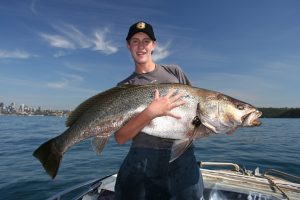
TIMES AND MOONS
I have caught jewies in the middle of the day on the right tides but the best times are when the high peaks early morning or late afternoon. You will find that this occurs around the full and new moons. New moon is best for early morning and into the day fishing. Full moon is best for late afternoon and into the night fishing.
WHERE
During daylight jewies are less active and generally go into ‘Holding’ mode. Holding is basically a period where jewies don’t do much and stay stationary. Jewies prefer to hold with their backs to some sort of structure and their eyes in the shade. I actually believe that they are resting at these times. I think that they like their backs to the structure to avoid attack from predators from behind.
Ideal hang outs include under deep water marinas, boat moorings, bridges and jetties. Shelving rocks and caves. found on the steep faces of reefs or headlands are also good spots. Wrecks that offer shelter are also worth a look. Areas where water eddies either horizontally or vertically are good signs as are deep holes and channels. Rocky shorelines that drop rapidly into deep water are good and if they occur off a point where there is some form of eddy this is even better.
Keep an eye on your sounder for steep drop offs particularly if there appears to be overhangs on those drop-offs.
METHOD
Suspending the bait properly is critical. If it lies on the bottom it is both hard for the jewie to find and is prone to pickers. In shallow water situations (less than 25 ft) it may be necessary to cast well away from the boat. In this situation your bait will have to rest on the bottom. In most cases where the water is at the preferred depth of between 30 and 60 ft it is acceptable to suspend the bait straight under the boat. The boat will not worry the fish in these depths. Even more so if you are using a modern ‘spot lock’ style electric motor. Anchors tend to spook jewies, but they will return after a bit of time
Let your sinker hit the bottom and then pull it up about three meters. With a one and a half meter trace your bait will be suspended at one and a half meters above the bottom.
When the fish takes the bait hit it immediately. A lot of people reckon you should let them run before striking but in my experience this loses more fish than it catches.
If a big fish swims off with your bait, there is only one place he can be holding it and that is in his mouth. If your hook is in the bait, then it too is in the fishes mouth. If the hook is in the fishes mouth, then I can’t imagine why you would want to do anything other than strike.
Talk of jewwies swimming around with your bait in its lips for a hundred meters then spitting it out and sucking it back in again before swallowing it is just garbage.
They are a big, hungry and aggressive animal. They wolf a bait down aggressively and then if all is not right, go about the process of rejecting it.
I fish with the rod in the holder, in gear with a normal drag setting. Ninty five percent of the time the fish is hooked as soon as it takes the bait. My experience with letting fish run for long periods before striking is that you will drop ninety five percent of them Once the fish is hooked then naturally it must be allowed to take line against your standard drag setting as with any fish.
To back up my theory, I know professional line fishermen who use exactly the same technique when chasing jew. They fish from springers and the fish is hooked instantly. These guys make their living from fishing and Im sure that if there was a better method of catching jews then they would be doing it.
Being a big schooling fish, they are also very competitive. Most times when they hit, it is with the veracity of a school of tailor, usually with all the rods going off at almost the same time. It’s a wild scene down there.
If Jewies fooled around with a bait like some people suggest they do it would be snatched off them by another fish before they knew what had hit them.
So, the longer you give them without striking the greater the chance that they will reject it. The hook, line, swivel and sinker will feel unusual to them and make the bait very hard to swallow. Even in free spool there will be resistance from water pressure on the line and friction of the line going over the guides.
In my opinion the longer you take to strike the more likely the fish is to reject the bait.
You hear guys talking repeatedly about their last jewie session and how they had six jewie ‘runs’ but just couldn’t hook them. They go on to say how they let each fish run for longer than the last in the hope that they will swallow the bait.
The key word here is ‘runs’ and in fact the longer the runs the less likely they were to secure a hookup. Every second a fish has a bait in its mouth is another second it has to reject it
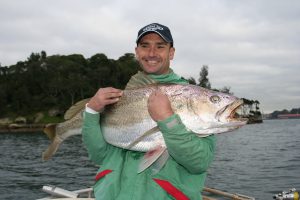
TACKLE
They don’t fight much so 15kg line should be ample. 20 kg would be appropriate in you are targeting really big fish
The choice of tackle is not critical but a threadline or overhead with a capacity of about 250 yards on a matching rod would be close to the mark
RIG
The sinker should be big enough to hold the line vertical in the current. It is put straight on the main line and a swivel is then tied to the end of the main line. A nylon trace of 20 to 30 kg and about 1.5m long is then tied to the swivel the hook is then tied to the end.
SEASON
Although jews can be taken all year round the best times are through the warm water times. I find November and December
to be the prime months at the start of the season. April to June, marks the end of the season and is probably the best time of all. The summer months in between these peak periods are good and the fish are abundant but generally smaller.
Keep your Jewie trips short and efficient. Sitting there all day or all night really doesn’t increase your chances that much. The average
trip only needs to last four hours — one and a half to catch squid half to get to the spot and get in position and two to catch a few jewies. The chances of catching any after that are so slim it’s hardly worth the effort.
Get the right bait, be on the right spot at the right time and I think you will be surprised how soon a jewie comes your way.
Pics and article by Craig McGill
